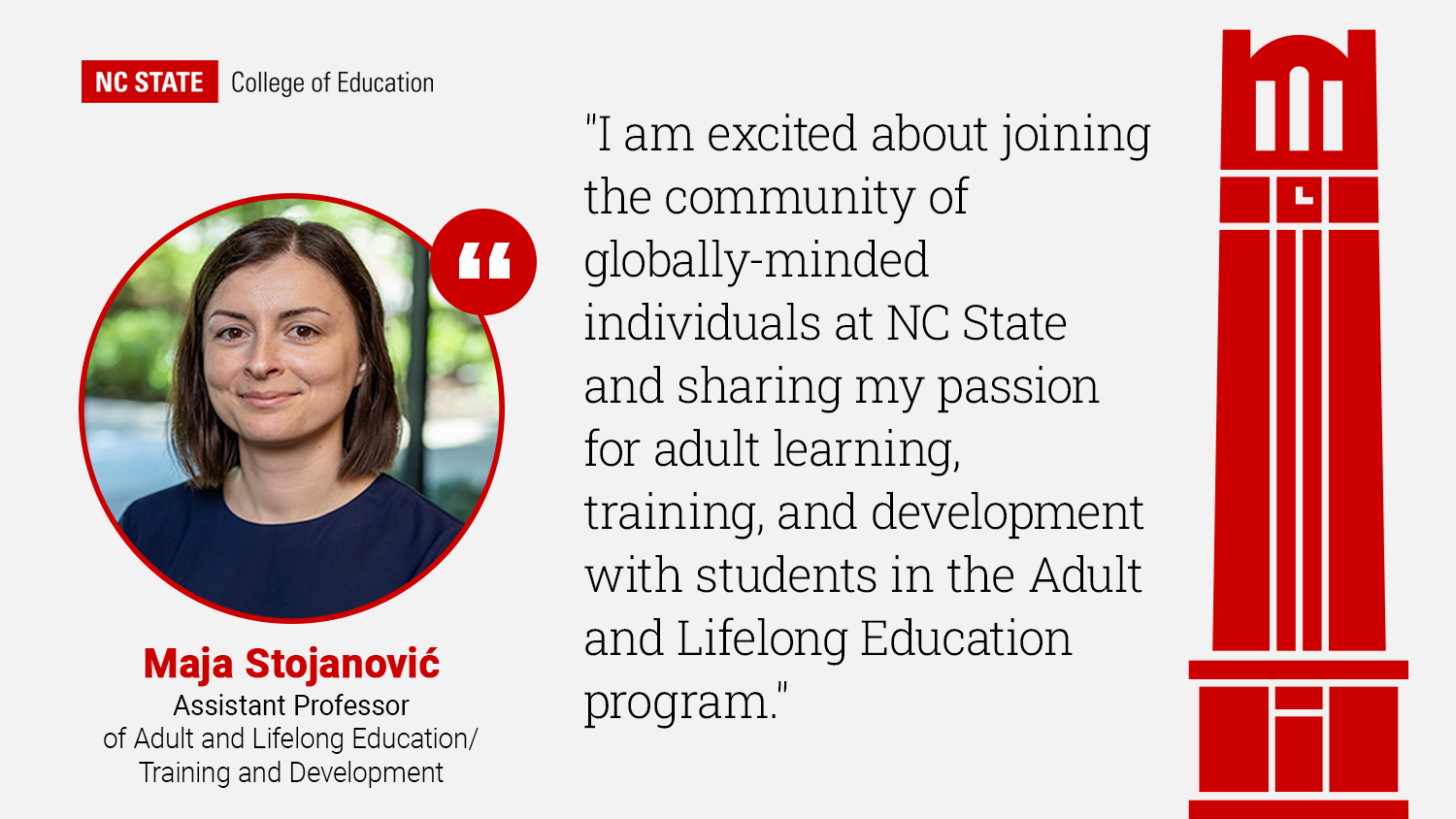Ask the Expert: How Can Online Learning Opportunities Provide Quality Educational Experiences During the COVID-19 Outbreak? Through Intentional Design and Reasonable Expectations, Says Teaching Associate Professor Angie Smith

This is part of the monthly “Ask the Expert” series in which NC State College of Education faculty answer some of the most commonly asked questions about education.
As schools and universities increasingly move to online and remote learning to help mitigate the spread of the Coronavirus (COVID-19) outbreak, NC State College of Education Teaching Associate Professor Angie Smith, Ph.D., says that, with a thoughtful and strategic approach, educators can continue to deliver a high-quality education for their students at home.

“I think some of the most significant benefits of online learning are around access, flexibility and convenience. We are able to include a multitude of learners in our environment who can join us from around the state, country and world,” said Smith, who co-authored Developing Online Learning in the Helping Professions.
Online learning has always been a popular choice for students who work or take care of children, students serving in the military or those who live in rural areas where access to a physical campus would be difficult.
In recent weeks, as the world works to curb the spread of COVID-19 through social distancing practices, it has also become a way to ensure that education is not interrupted.
“As we are facing unprecedented times that call for social distancing practices, online learning can offer support through continuity of operations and additional opportunities for connectedness,” said Smith. “The online learning environment can provide a way to continue learning in the short-term and aid the process for students and faculty to remain connected.”
[spotlight-box label=”” img=”32755″ align=”left” heading=”Providing Support During COVID-19″ cta=”Visit the COVID-19 Tips and Resources Page” url=”https://ced.ncsu.edu/news-new/coronavirus-college-updates/resources-for-covid-19/“]The NC State College of Education is committed to supporting educators, students and parents as they teach and learn remotely during the coronavirus (COVID-19) pandemic. To help with this, we have created a page dedicated to providing tips and resources to ease the transition to at-home learning[/spotlight-box]
Smith said online learning can take on many forms, including asynchronous or synchronous learning environments.
Synchronous learning allows students and instructors to interact in real-time, similar to the way an in-person class would have a scheduled date and time, and can occur using tools like the video conferencing app Zoom. Asynchronous learning, on the other hand, allows students to interact with the content, and each other, at their own pace through learning management systems like Moodle.
Smith notes that preparing online classes of either variety during the rapidly changing situation surrounding the COVID-19 pandemic has created unique circumstances that are not typically present during traditional online learning.
Typically, educators who instruct online courses have time to develop an intentional course map designed for an online environment and build in a learning curve to allow for the introduction of technologies and tools that might be relevant to the course. Instructors generally have an online course fully planned before the semester begins, but now many educators have had to adapt their courses to an online format in just a matter of weeks.
For this reason, Smith says that students, educators and administrators should set reasonable expectations for what these online courses will look like.
“We must recognize that moving content online during an emergency, short-term situation can be limiting and different than building and designing a class with ample time to do so effectively,” she said. “It is essential to think about our own bandwidth, and that of our students, in the short timeframe while we manage the workload, adaptations to assignments and the learning curve for all involved.”
Despite the challenges, there are several ways that educators can continue to keep students engaged in an online learning environment and continue to ensure they receive the same high-quality instruction they would have received in the classroom.
Educators should consider their course content, intended learning outcomes, class size and the types of learners in their class in order to tailor instruction. For example, live sessions through platforms like Zoom or Google Hangouts could be used like a traditional classroom to facilitate discussions, role playing or group work. Padlet, an interactive collaborative bulletin board, can help students and instructors share ideas while Playposit, an interactive video tool, allows students to add annotations and questions to a recorded lesson.
[spotlight-box label=”” img=”” heading=”Helpful Tools for Effective Online Instruction” cta=”” url=””] Teaching Associate Professor Angie Smith, Ph.D., recommends some of the following tools to help educators transition to effective online instruction:
- Zoom, a video conferencing app, allows educators and students to interact face-to-face and remain connected while practicing social distancing. Educators can use this synchronous tool to hold classroom discussions or host office hours. This platform can accommodate up to 300 users at once.
- Moodle, an asynchronous, open-source learning management tool, allows educators to communicate with students and provide educational activities and resources. The system allows for the creation of online tests and quizzes, receiving and posting assignments and posting grades.
- Padlet is an interactive collaborative bulletin board that can be integrated with Moodle and allows students to share ideas.
- Playposit which can be added to Moodle, allows educators to create interactive videos and presentations.
- PoodLL is a video capability embedded in Moodle that can be used for recording a video journal, asking questions and sharing information.
- VoiceThread allows educators to record videos, presentations and interactive discussion forums that students can connect to via audio, text or video.
- Flipgrid, a video tool, can be used to have students record videos of themselves for introduction purposes or as part of a presentation assignment. [/spotlight-box]
Students will continue to receive a high-quality educational experience during the transition from physical classrooms to online learning environments as long as instructors remain connected to students by demonstrating concern and keep in mind that all learners are experiencing varied levels of stress amidst the changes, Smith said. Additionally, educators are encouraged to be intentional about course design, define clear learning objectives and identify ways to effectively assess students in the online environment, Smith said.
“Faculty are content experts and truly bring the content to life. In the online environment, it may look a little different. However, there are ways to deliver content, connect with students and teach in a way that meets students where they are,” Smith said.
As faculty and other educators prepare online courses, Smith said that they should keep things simple, and try to avoid simply mirroring the traditional classroom in an online format. For example, while a traditional classroom lecture may last 30 minutes, Smith said it is recommended to break content into a series of 10 minute video segments when teaching online.
In addition, educators should remain in contact with students and gather feedback about which online learning tools are working effectively and which are not. However, educators and students should remember to set boundaries around communication, as an online learning environment is always on and can blur the line set firmly in place by in-person class schedules and office hours.
“Even though online learning can feel like it is 24/7, you do not have to be available and accessible at all hours of the day and night, or on the weekend. Share this with students in the syllabus, your online learning space and in live sessions as well,” Smith recommended.
With no clear beginning and end times for many online learning environments, Smith said it is important that educators and students remember to pace themselves, take breaks to stretch and rest their eyes and continue to remain connected to family, friends, colleagues and their support system.
In addition, she reminds educators that they should reach out for support or resources if they are feeling overwhelmed by the changes.
“During this unprecedented time, be gentle with yourself and support one another,” Smith said. “Check in on each other through some of the online platforms and reach out to students to connect, demonstrate care and even provide words of encouragement.”
- Categories:


